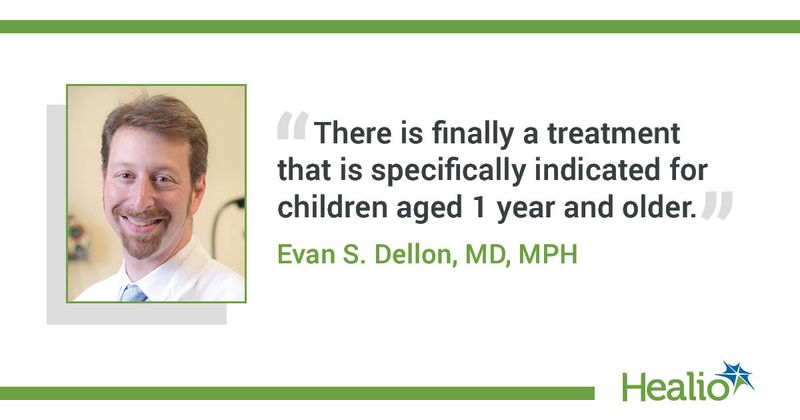Q&A: Improved outcomes anticipated with dupilumab for children with EoE
Key takeaways:
- Children with eosinophilic esophagitis currently rely on elimination diets.
- The safety profile for this age group was consistent with the safety profiles of older patients.
Treatment options for children with eosinophilic esophagitis have expanded with the FDA’s approval of dupilumab for those aged 1 to 11 years who weigh at least 15 kg, according to a press release.
The approval came after a priority review including data from parts A and B of the phase 3 EoE KIDS trial. Healio spoke with Evan S. Dellon, MD, MPH, director of the Center for Esophageal Diseases at the UNC School of Medicine and author on the EoE KIDS trial, to find out more.

Healio: What kind of impact does EoE have on children in this age group?
Dellon: EoE is a chronic, progressive disease driven in part by type 2 inflammation that damages the esophagus and impairs its function. It can severely impact a child’s ability to eat, and they may experience heartburn, vomiting, abdominal discomfort, trouble swallowing, food refusal and failure to thrive. It also can adversely impact their growth and development.
Symptoms of EoE can be mistaken for other conditions and delays in diagnosis are common, indicating the disease may be underdiagnosed. Maintenance treatment of EoE may be needed to reduce the risk for complications and disease progression. About 40% of the approximately 21,000 children aged younger than 12 years in the U.S. may not satisfactorily respond to the previously available therapies with which they have been treated and may potentially require biologic therapy.
Healio: What is the current treatment for EoE in this age group, and what are its limitations?
Dellon: Dupilumab (Dupixent; Regeneron, Sanofi) is the only medicine approved in the U.S. specifically indicated to treat EoE in patients aged 1 year and older weighing at least 15 kg. Before this approval, the main treatment approaches were elimination diets, which could be quite restrictive, as well as the use of treatments not approved for the disease, such as proton pump inhibitors and swallowed topical corticosteroids. Even with these options, treatment responses were suboptimal, there were access issues, and the pharmacologic treatments did not target the root cause of EoE.
Healio: How does dupilumab improve upon these limitations?
Dellon: By targeting the underlying type 2 inflammation that contributes to this disease, dupilumab is working to treat the symptoms and inflammatory mechanisms of EoE in children that can adversely impact their growth and development. As the only approved therapy specifically indicated for this age group impacted by EoE, it has the potential to transform the standard of care.
Healio: Were there any particularly surprising or significant findings in the phase 3 EoE KIDS trial that you would like to spotlight?
Dellon: At 16 weeks, 66% of children who received higher dose dupilumab achieved histological disease remission (≤ 6 eosinophils/high power field). Histological remission was sustained at week 52, with 53% of children treated with dupilumab in parts A and B maintaining remission, and newly achieved in 53% of children who switched to dupilumab from placebo in part B. Moreover, this efficacy was achieved with a well-tolerated safety profile, consistent with other studies of dupilumab.
Healio: What makes these findings significant?
Dellon: This is significant because it represents a milestone moment for a population who, until now, has had significant unmet medical needs. Moreover, even though these results are similar to what was seen in the phase 3 trial of patients with EoE aged 12 years and older, it is the first time dupilumab has been rigorously tested in this younger patient group with EoE. Now there is finally a treatment that is specifically indicated for children aged 1 year and older, weighing at least 15 kg.
Healio: Do you have any recommendations for doctors who would like to begin prescribing dupilumab for children with EoE?
Dellon: I encourage physicians to read about the trial to learn more about the data and work with families on a treatment plan that works best for pediatric patients.
